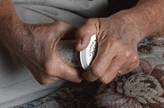Deadly epidemic is driven by abuse of narcotic painkillers and heroin.
(HealthDay)—As deaths from heroin and prescription painkillers mount across the United States, government officials are searching for ways to stem the toll of addiction.
The death last week of Oscar-winning actor Philip Seymour Hoffman, 46, in New York City from an apparent heroin overdose highlighted this escalating problem.
"The use of opioids—a group of drugs that includes heroin and prescription painkillers—is having a devastating impact on public health and safety in communities across the nation," Gil Kerlikowske, director of the U.S. Office of National Drug Control Policy, said during a Tuesday morning news conference in Washington, D.C.
"In 2010, approximately 100 Americans died from overdoses every day," Kerlikowske said. Prescription painkillers were involved in more than 16,600 deaths that year, and heroin was involved in about 3,000 deaths, he added.
Overdose deaths now surpass deaths from murder and car crashes in America, he said.
Heroin's popularity has soared in recent years—jumping to 669,000 users in 2012 from 373,000 in 2007, according to government figures provided at the news conference. However, heroin is still much less common than other drugs, Kerlikowske added.
Heroin's resurgence is partly the result of increased availability and lower cost relative to other drugs, he said.
Speaking at the news conference, Dr. Wilson Compton, deputy director of the U.S. National Institute on Drug Abuse, explained that heroin is an opioid, as is morphine and commonly prescribed painkillers like hydrocodone and oxycodone.
"These are all classified as opioids because they exert their effect by attaching to the opioid receptor found in our brain and spinal cord," Compton said.
Besides blocking the transmission of pain, "opioids also cause pleasurable sensations," Compton said. "It's through that mechanism that abuse can result in physical dependency and addiction."
These drugs also slow breathing and heart activity, Compton said. "These functions can be slowed to such an extent that they often result in a coma or death," he said.
The heroin epidemic is linked to prescription drug abuse, Kerlikowske said. "Many individuals who develop a substance abuse disorder or who overdose begin by misusing prescription drugs," he said.
To break this link, the federal government has begun to crack down on "pill mills" and doctors who over-prescribe narcotic painkillers. It has also developed education programs for doctors and patients on prescribing painkillers and disposing of unused prescriptions.
Nearly 80 percent of people who recently started using heroin had previously used prescription pain relievers illegally, according to a U.S. Substance Abuse and Mental Health Services Administration report issued last April.
Hoffman's death, despite his efforts to stay clean, reminds experts that any fight against heroin must be broad and multi-pronged.
Waging a campaign against drugs isn't a simple matter of law enforcement, Kerlikowske said.
Seizures of heroin along the Mexican border increased 324 percent from 2008 to 2013, he said, but even rural areas of the United States are finding heroin easy to come by.
"It is clear we are not going to arrest our way out of this problem. Science has shown that drug addiction is a disease of the brain—a disease that can be prevented, treated and from which one can recover," Kerlikowske said.
Wider use of the drug naloxone would help curb drug-related deaths, Kerlikowske said. When given to someone suffering an overdose, naloxone can almost immediately counteract a drug's lethal effect and save that person's life, he said.
Kerlikowske believes that first responders, such as police and EMTs, should routinely carry naloxone. "Saving a life is more important than making an arrest," he said.
In New York state, legislators this week proposed a bill that would allow a trained layperson to administer naloxone to someone at risk of an overdose.
Making treatment available for drug addiction is also a key tool, Kerlikowske said.
Under the Affordable Care Act, insurance companies are required to cover treatment for drug addiction just as they would treatment for any other chronic disease, he said.
Drugs used to treat chronic addiction include naltrexone (Narcan), buprenorphine (Buprene) and methadone, Kerlikowske said.
"Medication-assisted treatment has already helped thousands of people in long-term recovery," he said.
More information: For more on drug abuse, visit the U.S. Substance Abuse and Mental Health Services Administration.
Copyright © 2014 HealthDay. All rights reserved.




















